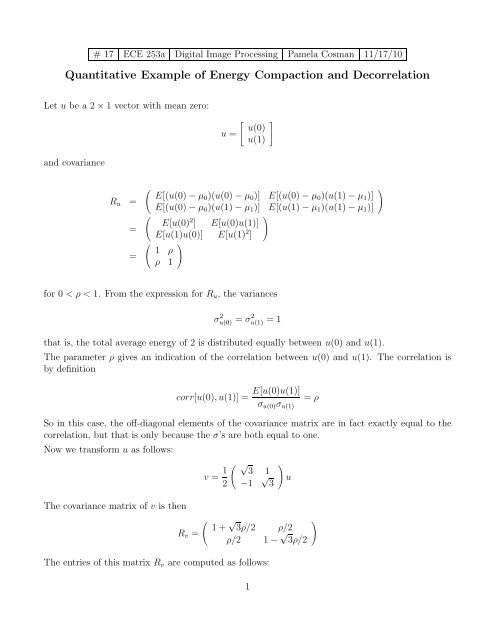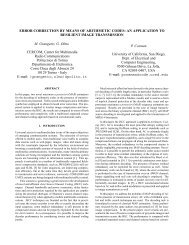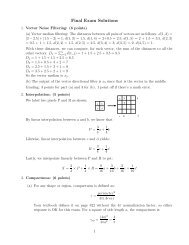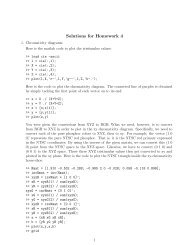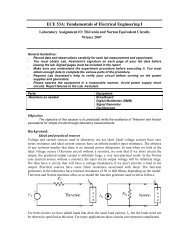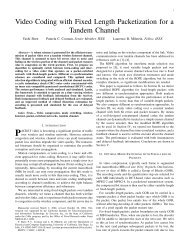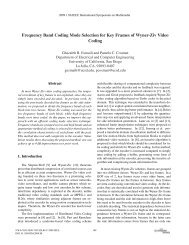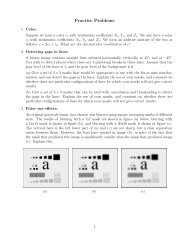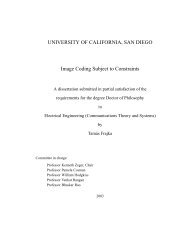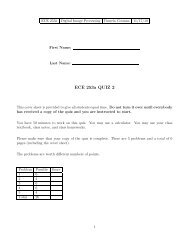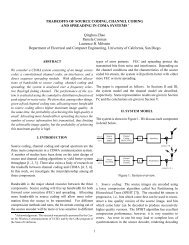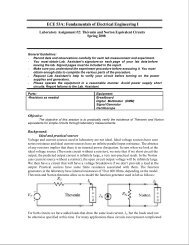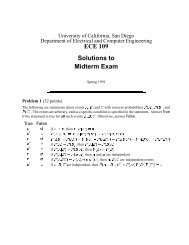Quantitative Example of Energy Compaction and Decorrelation
Quantitative Example of Energy Compaction and Decorrelation
Quantitative Example of Energy Compaction and Decorrelation
You also want an ePaper? Increase the reach of your titles
YUMPU automatically turns print PDFs into web optimized ePapers that Google loves.
# 17 ECE 253a Digital Image Processing Pamela Cosman 11/17/10<br />
<strong>Quantitative</strong> <strong>Example</strong> <strong>of</strong> <strong>Energy</strong> <strong>Compaction</strong> <strong>and</strong> <strong>Decorrelation</strong><br />
Let u be a 2 × 1 vector with mean zero:<br />
<strong>and</strong> covariance<br />
Ru =<br />
=<br />
=<br />
u =<br />
<br />
u(0)<br />
u(1)<br />
<br />
<br />
E[(u(0) − µ0)(u(0) − µ0)] E[(u(0) − µ0)(u(1) − µ1)]<br />
E[(u(0) − µ0)(u(1) − µ1)] E[(u(1) − µ1)(u(1) − µ1)]<br />
<br />
E[u(0) 2 ] E[u(0)u(1)]<br />
E[u(1)u(0)] E[u(1) 2 <br />
]<br />
<br />
1 ρ<br />
ρ 1<br />
for 0 < ρ < 1. From the expression for Ru, the variances<br />
<br />
σ 2 u(0) = σ 2 u(1) = 1<br />
that is, the total average energy <strong>of</strong> 2 is distributed equally between u(0) <strong>and</strong> u(1).<br />
The parameter ρ gives an indication <strong>of</strong> the correlation between u(0) <strong>and</strong> u(1). The correlation is<br />
by definition<br />
corr[u(0), u(1)] = E[u(0)u(1)]<br />
= ρ<br />
σu(0)σu(1)<br />
So in this case, the <strong>of</strong>f-diagonal elements <strong>of</strong> the covariance matrix are in fact exactly equal to the<br />
correlation, but that is only because the σ’s are both equal to one.<br />
Now we transform u as follows:<br />
The covariance matrix <strong>of</strong> v is then<br />
Rv =<br />
v = 1<br />
√<br />
3 1<br />
2 −1 √ 3<br />
<br />
<br />
u<br />
1 + √ 3ρ/2 ρ/2<br />
ρ/2 1 − √ 3ρ/2<br />
The entries <strong>of</strong> this matrix Rv are computed as follows:<br />
1
√<br />
3 1<br />
v(0) = u(0) +<br />
2 2 u(1)<br />
E[v(0) 2 ] = 3<br />
√<br />
1 3<br />
+ + 2<br />
4 4 4 ρ<br />
etc. Now if we compare the energy <strong>of</strong> the two coordinates:<br />
σ 2 v(0) = 1 + √ 3ρ/2<br />
σ 2 v(1) = 1 − √ 3ρ/2<br />
we see that the total average energy is still 2, but now the energy in v(0) is greater than in v(1). If<br />
ρ = 0.95, then 91.1% <strong>of</strong> the total average energy has been packed in the first sample.<br />
σ 2 v(0) = 1.82 σ2 v(1)<br />
The correlation between v(0) <strong>and</strong> v(1) is given by<br />
ρv(0,1) = E[v(0)v(1)]<br />
=<br />
σv(0)σv(1)<br />
ρ<br />
= 0.18<br />
2 <br />
(1 − 3<br />
4 ρ2 )<br />
which is less in absolute value than | ρ | for | ρ |< 1 For ρ = 0.95, we find ρv(0,1) = 0.83. Hence the<br />
correlation between the transform coefficients has been reduced.<br />
Suppose instead we use the transform matrix<br />
then we find<br />
A = 1 √ 2<br />
σ 2 v(0)<br />
σ 2 v(1)<br />
<br />
1 1<br />
1 −1<br />
= 1 + ρ<br />
= 1 − ρ<br />
ρv(0,1) = 0<br />
For ρ = 0.95, now 97.5% <strong>of</strong> the energy is packed into v(0), <strong>and</strong> the two components v(0) <strong>and</strong> v(1)<br />
are uncorrelated.<br />
2
DCT basis images for 8x8 blocks:<br />
Luminance Quantization Table:<br />
16 11 10 16 24 40 51 61<br />
12 12 14 19 26 58 60 55<br />
14 13 16 24 40 57 69 56<br />
14 17 22 29 51 87 80 62<br />
18 22 37 56 68 109 103 77<br />
24 35 55 64 81 104 113 92<br />
49 64 78 87 103 121 120 101<br />
72 92 95 98 112 100 103 99<br />
Chrominance Quantization Table:<br />
17 18 24 47 99 99 99 99<br />
18 21 26 66 99 99 99 99<br />
24 26 56 99 99 99 99 99<br />
47 66 99 99 99 99 99 99<br />
99 99 99 99 99 99 99 99<br />
99 99 99 99 99 99 99 99<br />
99 99 99 99 99 99 99 99<br />
99 99 99 99 99 99 99 99<br />
3


